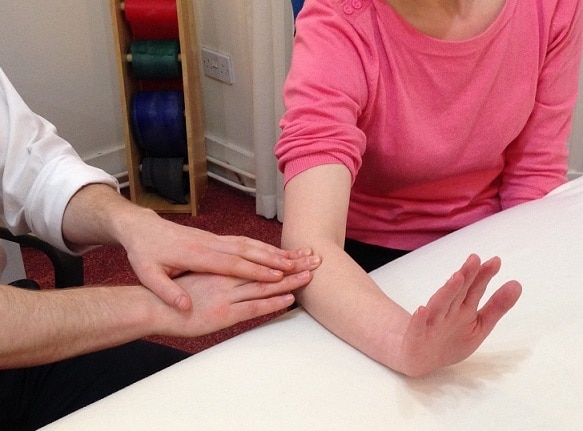Tennis elbow (lateral epicondylitis) is a condition which presents as pain at the outside of the elbow joint, which can spread down the outer aspect of the affected forearm. Tennis elbow is a repetitive strain or overuse injury. Tennis elbow pain is not just experienced by those who play tennis on a regular basis.
What Tissues Are Affected With This Condition?
Tennis elbow pain presents as pain, this pain being the result of repetitive micro-trauma to the common extensor tendon which eventually leads to the beginning of an inflammatory process in the muscles at the outside of the elbow and forearm. These muscles, and tendons, are responsible for movement of the elbow, wrist, and fingers, as well as being responsible for any gripping activities.
What Causes Tennis Elbow?
As mentioned above, tennis elbow is a repetitive strain injury – muscle tissue micro-trauma and inflammation are the result of everyday tasks which overload the implicated tissues over a prolonged period of time. These activities do not induce sufficient trauma in one episode to cause pain, but their accumulated effect is sufficient to do so.
Activities commonly seen to induce tennis elbow include prolonged gripping of sporting equipment (gold club etc.), persistent use of the hands for gripping (lifting heavy objects) or fine motor tasks (playing of musical instruments), or repetitive use of the fingers (typing etc.)
Tennis elbow can also present due to shoulder instability, with the muscles of the forearm & hand obliged to over work to compensate for this instability higher up.
How Does Tennis Elbow Present?
Typically, tennis elbow presents with a focal pain point just below the bony bump (lateral epicondyle) on the outside of the elbow. This pain can then spread down the forearm, often as far as the hand. Pain is not typically referred above the elbow.
Tennis elbow is often mistakenly diagnosed in the presence of neuropathic (nerve) pain in the arm. Specific, thorough assessment is vital if accurate diagnosis is to be achieved in this instance.
How Can Physiotherapy Help
Many physiotherapy treatments have been shown to be successful in their treatment of tennis elbow. Treatment is tailored to suit the individual symptom presentation of the patient, following a thorough assessment. Treatment may include
- Transverse friction massage
- Acupuncture
- Taping
- Joint mobilization with movement (MWM)
- Trigger point release
- Strengthening & eccentric strengthening
- Advice on activity modification
What Can I Do To Help This Condition Myself?
Prior to, or while attending physiotherapy, the patient can also help the recovery process by following several steps
• Applying a cold compress (bag of ice wrapped in a tea towel) to the painful site, for approximately 5 minutes, several times daily This will serve to reduce pain-inducing swelling
• Avoid undertaking any activities which involve repetitive use of the wrist of forearm muscles – this will reduce the stress placed on the tendon at the outside of the elbow, the tendon implicated in the condition of “tennis elbow”.
• Undertake gentle “self massage” to the muscle on the outside of the elbow, where the primary point of pain is located. This can involve simply placing the pad of one or two fingers from the opposite hand onto the painful spot, applying a gentle pressure, & moving the fingers in a circular motion or a motion parallel to the elbow.
• An epiclasp can be worn around the upper end of the forearm (just below the elbow). This adjustable clasp will reduce localised pressure on the tendon at the outside of the elbow, instead inducing a more general absorption of tension about the elbow. This reduction in pressure will serve to both reduce irritation, and also encourage healing.
Golfers’ Elbow
Golfers’ Elbow is almost identical to tennis elbow in terms of cause and symptom presentation, however it presents on the medial (inside) aspect of the elbow. The causative mechanism is again one of overuse and repetitive microtrauma, with activity modification and physiotherapy again the primary treatments of choice.

